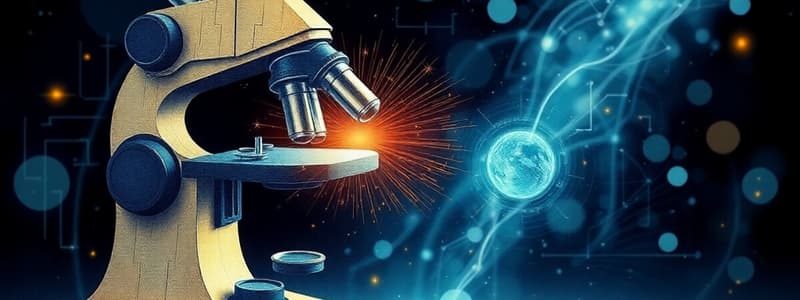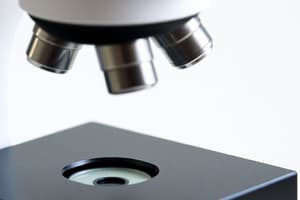Podcast
Questions and Answers
What was the primary function of early glass lenses in ancient times?
What was the primary function of early glass lenses in ancient times?
- To create powerful telescopes
- To magnify small text
- To start fires and cauterize wounds (correct)
- To improve eyesight in low light
Who is credited with inventing the first wearable eyeglasses?
Who is credited with inventing the first wearable eyeglasses?
- Giovanni Faber
- Hans Janssen
- Antonie van Leeuwenhoek
- Salvino D’Armate (correct)
Which feature defines a compound microscope invented by Hans and Zacharias Janssen?
Which feature defines a compound microscope invented by Hans and Zacharias Janssen?
- Use of digital sensors for imaging
- Incorporates advanced optical fibers
- Two lenses and an extendable tube (correct)
- Single lens capable of high magnification
What does the term 'microscope' derive from?
What does the term 'microscope' derive from?
Which historical figure significantly contributed to the observation of microorganisms?
Which historical figure significantly contributed to the observation of microorganisms?
What magnification range could the Janssen compound microscope achieve?
What magnification range could the Janssen compound microscope achieve?
What was the role of the 'burning lens' allegedly used by Archimedes?
What was the role of the 'burning lens' allegedly used by Archimedes?
Which invention preceded the creation of eyeglasses in history?
Which invention preceded the creation of eyeglasses in history?
Why was the creation of the optical instrument by Galileo Galilei significant?
Why was the creation of the optical instrument by Galileo Galilei significant?
What notable ability did Antonie van Leeuwenhoek's microscopes provide?
What notable ability did Antonie van Leeuwenhoek's microscopes provide?
Who is often referred to as the 'Father of Microbiology'?
Who is often referred to as the 'Father of Microbiology'?
What significant term did Robert Hooke coin while observing cork?
What significant term did Robert Hooke coin while observing cork?
What year was the Modern Cell Theory proposed?
What year was the Modern Cell Theory proposed?
Which of the following inventions did Carl Zeiss contribute to the field of microscopy?
Which of the following inventions did Carl Zeiss contribute to the field of microscopy?
What does the Cell Doctrine state about cells?
What does the Cell Doctrine state about cells?
In what context is the importance of microscopy highlighted?
In what context is the importance of microscopy highlighted?
What did Rudolf Virchow add to the Modern Cell Theory?
What did Rudolf Virchow add to the Modern Cell Theory?
Which company became a leader in the microscope industry during the 19th century?
Which company became a leader in the microscope industry during the 19th century?
Which of the following advancements is NOT associated with modern microscopy?
Which of the following advancements is NOT associated with modern microscopy?
What was a common issue related to collaboration in early scientific advancements?
What was a common issue related to collaboration in early scientific advancements?
Flashcards
Microscope
Microscope
An instrument, using glass lenses, to enlarge images of small objects not visible to the naked eye.
Compound Microscope
Compound Microscope
A microscope with two or more lenses to achieve higher magnification than one lens.
Hans & Zacharias Janssen
Hans & Zacharias Janssen
Invented the first compound microscope.
Antonie van Leeuwenhoek
Antonie van Leeuwenhoek
Signup and view all the flashcards
Light Microscopy
Light Microscopy
Signup and view all the flashcards
Single-lens microscope
Single-lens microscope
Signup and view all the flashcards
Magnification
Magnification
Signup and view all the flashcards
First Compound Microscope Year
First Compound Microscope Year
Signup and view all the flashcards
Galileo Galilei's Microscope
Galileo Galilei's Microscope
Signup and view all the flashcards
Archimedes' Burning Lens
Archimedes' Burning Lens
Signup and view all the flashcards
Cell Doctrine
Cell Doctrine
Signup and view all the flashcards
Robert Hooke
Robert Hooke
Signup and view all the flashcards
Modern Cell Theory
Modern Cell Theory
Signup and view all the flashcards
Theodor Schwann and Matthias Schleiden
Theodor Schwann and Matthias Schleiden
Signup and view all the flashcards
Rudolf Virchow
Rudolf Virchow
Signup and view all the flashcards
Microscopy Improvements
Microscopy Improvements
Signup and view all the flashcards
Microscopes - Impact
Microscopes - Impact
Signup and view all the flashcards
Carl Zeiss
Carl Zeiss
Signup and view all the flashcards
Hooke's 'Micrographia'
Hooke's 'Micrographia'
Signup and view all the flashcards
Microscope Evolution
Microscope Evolution
Signup and view all the flashcards
Study Notes
Introduction to Microscopes
- Microscopes are instruments that allow viewing objects invisible to the naked eye.
- Key feature is glass lenses that bend light to enlarge images on the retina.
Historical Development of Microscopes
Early Use of Lenses
- Ancient Greece: Archimedes allegedly used a "burning lens" to focus sunlight on ships, though its practicality is doubtful.
- Romans: Experimented with glass lenses. Used lenses as "burning glasses" for starting fires and cauterizing wounds. Noted magnification effects when moving glass over text or images. Emperor Nero used an emerald to reduce glare during gladiator matches – a precursor to sunglasses.
First Vision Aids
- Reading Stone (800s): Invented by Abbott Furness, a curved glass piece used to magnify text.
- Eyeglasses (1284): Italian inventor Salvino D'Armate created the first wearable eyeglasses.
Emergence of Microscopes
- First Compound Microscope (1595): Invented by Hans and Zacharias Janssen (father and son) in Holland. Consisted of two lenses and an extendable tube, achieving magnifications of 3x to 10x. A foundational design still influencing modern microscopes.
- Galileo Galilei (1609): Invented his version of the compound microscope, the "occhiolino" (little eye). Also developed the telescope.
- Introduction of the Term "Microscope" (1624): Coined by Giovanni Faber, combining Greek words "micro" (small) and "scopein" (to see).
Advancements in Microscopy
- Antonie van Leeuwenhoek (1632-1723): Crafted high-quality single-lens microscopes, magnifying up to 270x. First to observe and describe bacteria, yeast, red blood cells, and sperm cells. Often called the "Father of Microbiology."
- Robert Hooke (1635-1703): Developed compound microscopes with added light sources. Published "Micrographia" (1665), documenting microscopic observations. Coined the term "cell" while observing cork.
Scientific Breakthroughs and Theories
- Cell Doctrine (1839): Proposed by Theodor Schwann and Matthias Schleiden. Cells are the basic structural and physiological units of living organisms. Cells function as independent entities and building blocks of organisms. Modern Cell Theory (1855): Rudolf Virchow added: "All cells arise from pre-existing cells."
Technological and Industrial Developments
- 19th Century: Improved engineering enabled higher precision in lens crafting and microscope design. Companies like Zeiss in Germany became leaders in the microscope industry, integrating advanced optics and engineering. Key Innovators: Carl Zeiss: Revolutionized microscope manufacturing. Charles Spencer: Produced finely adjustable and precise microscopes.
Impact and Legacy
- Modern microscopes remain based on principles developed by pioneers like Janssen, Galileo, Hooke, and van Leeuwenhoek. Microscopes have enabled critical discoveries in microbiology, medicine, and materials science.
Key Takeaways
- Microscopy's Evolution: From simple lenses to advanced light and fluorescence microscopes.
- Importance: Central to scientific discovery and understanding of biological structures.
Collaboration and Controversy
- Many key theories and inventions arose from building upon others' work, sometimes without proper acknowledgement.
Studying That Suits You
Use AI to generate personalized quizzes and flashcards to suit your learning preferences.




